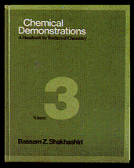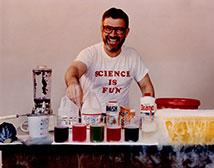

Demonstrations in Volume 3
8. ACIDS AND BASES
Rodney Schreiner, Bassam Z. Shakhashiri, David B. Shaw, Ronald I. Perkins, and Frederick H. Juergens
- 8.1 Colorful Acid-Base Indicators
- 8.2 Rainbow Colors with Mixed Acid-Base Indicators
- 8.3 Invisible Painting
- 8.4 Acid-Base Indicators Extracted from Plants
- 8.5 Classical Properties of Acids and Bases
- 8.6 Food Is Usually Acidic, Cleaners Are Usually Basic
- 8.7 Differing Properties of Four Common Acids
- 8.8 Etching Glass with Hydrogen Fluoride
- 8.9 "Coin-Operated Red, White, and Blue Demonstration": Fountain Effect with Nitric Acid and Copper
- 8.10 Fountain Effect with Ammonia, Hydrogen Chloride, and Indicators
- 8.11 Fizzing and Foaming: Reactions of Acids with Carbonates
- 8.12 Sealed-Bag Reactions with Acids and Bases
- 8.13 Hydrolysis: Acidic and Basic Properties of Salts
- 8.14 Acidic and Basic Properties of Oxides
- 8.15 Colors, Bubbles, and Fog: Acidic Properties of Carbon Dioxide in Aqueous Solutions
- 8.16 Acidic Properties of Nitrogen(IV) Oxide
- 8.16 Acidic Properties of Combustion Products of Sulfur, Nitrogen, and Chlorinated Polymers
- 8.18 Acid-Neutralizing Capacity of Lake Beds
- 8.19 Amphoteric Properties of the Hydroxides of Aluminum, Zinc, Chromium, and Lead
- 8.20 Differences Between Acid Strength and Concentration
- 8.21 Conductivity and Extent of Dissociation of Acids in Aqueous Solution
- 8.22 Effects of Ion-Exchange Resins on pH and Solution Conductivity
- 8.23 End Point of an Acid-Base Titration Determined by Electrical Conductivity
- 8.24 Effect of Acetate Ion on the Acidity of Acetic Acid: Common Ion Effect
- 8.25 Effect of Molecular Structure on the Strength of Organic Acids and Bases in Aqueous Solutions
- 8.26 Determination of Neutralizing Capacity of Antacids
- 8.27 Instrumental Recording of a Titration Curve
- 8.28 Buffering Action and Capacity
- 8.29 Buffering Action of Alka-Seltzer
- 8.30 Effect of pH on Protein Solubility
- 8.31 Lewis Acid-Base Properties of Aluminum Chloride and Hydrogen Chloride
- 8.32 Reaction Between Ammonia and Hydrogen Chloride
9. LIQUIDS, SOLUTIONS, AND COLLOIDS
Worth E. Vaughan, Rodney Schreiner, Bassam Z. Shakhashiri, and David B. Shaw
- 9.1 Volume Changes upon Mixing
- 9.2 Density and Miscibility of Liquids
- 9.3 The Dependence of Volume on Temperature: Coefficients of Thermal Expansion
- 9.4 Boiling Water in a Paper Cup: Heat Capacity of Water
- 9.5 Vapor Pressure of Pure Liquids and Solutions
- 9.6 Evaporation as an Endothermic Process
- 9.7 Liquid-Vapor Equilibrium
- 9.8 Boiling Liquids at Reduced Pressure
- 9.9 Vapor Pressure of a Solution (A Corridor Display)
- 9.10 Separating Liquids: Fractional Distillation
- 9.11 Failing to Separate Liquids: Azeotropy
- 9.12 Salting Out: Making Liquids Immiscible
- 9.13 Effect of Temperature on the Solubility of Manganese(II) Sulfate Hydrates
- 9.14 Chemical Cold Pack: Dissolution as an Endothermic Process
- 9.15 Heat of Solution of Lithium Chloride
- 9.16 Heat of Hydration of Copper(II) Sulfate
- 9.17 Volume Increase upon Neutralization
- 9.18 Effect of Temperature and Pressure on the Solubility of Gases in Liquids
- 9.19 Osmosis Through the Membrane of an Egg
- 9.20 Osmotic Pressure of a Sugar Solution
- 9.21 Getting Colder: Freezing-Point Depression
- 9.22 Getting Hotter: Boiling-Point Elevation by Nonvolatile Solutes
- 9.23 At the Water's Edge: Surface Spreading and Surface Tension
- 9.24 Will a Tissue Hold Water? Interfacial Tension
- 9.25 The Shape of Drops: Surface and Gravitational Work
- 9.26 The Ice Bomb: Expansion of Water as It Freezes
- 9.27 Flow of Liquids Through Pipes: Liquid Viscosities
- 9.28 Molecules in Slow Motion: Diffusion in Liquids
- 9.29 Facilitated Transport of Carbon Dioxide Through a Soap Film
- 9.30 Equilibration of Liquid Density via Diffusion
- 9.31 Electrical Conductivity of Liquids
- 9.32 Moving Liquids with Electricity: Dielectric Properties of Liquids
- 9.33 The Tubeless Siphon
- 9.34 Rod Climbing by a Polymer Solution
- 9.35 Snappy Liquid: Elastic Properties of a Soap Solution
- 9.36 Fog: An Aerosol of Condensed Water Vapor
- 9.37 Clean Air with the Cottrell Precipitator
- 9.38 A Collection of Foams: Some Suds for Drinking and Some for Washing
- 9.39 Solid Foams
- 9.40 Oil-Water Emulsions
- 9.41 Color of the Sunset: The Tyndall Effect
- 9.42 An Ancient Colloid: India Ink
- 9.43 Canned Heat: Alcohol Gels
- 9.44 "Slime": Gelation of Poly(vinyl alcohol) with Borax
- 9.45 Shake It and Move It: Thixotropy and Dilatancy
- 9.46 Staying Dry: Phase Transitions of a Poly(acrylamide) Gel
- 9.47 Growing Colorful Crystals in Gels
- 9.48 Liesegang Rings: Spatial Oscillation in Precipitate Formation
- 9.49 Colorful Stalagmites: The Silicate Garden
- 9.50 Colors and Shapes of Soap Films and Bubbles
- 9.51 Rotating Rainbows: A Solution in Polarized Light
- 9.52 Floating and Sinking: Osmosis Through a Copper Hexacyanoferrate(II) Membrane
Return to Series Description



